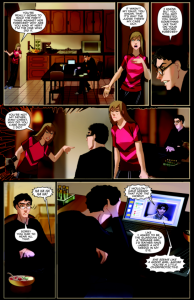
Written by Matt Hawkins
Art and standard cover by Linda Sejic
Published by Image Comics
Wildfire #1 is the first issue of Image’s latest high-concept series, one in which the world is threatened by genetically-modified plants. It’s an intriguing and certainly unique premise, but for a series like this to succeed, it needs to have something more than its initial hook, and it remains to be seen if Wildfire has that.
This is clearly a subject near to writer Matt Hawkins’ heart. The issue opens in media res, with Los Angeles ravaged by a massive wild fire, then steps back in time a few days to show readers what led to the fire. In the process, Hawkins presents both sides of the argument over genetically-modified-organisms (or GMOs). It’s unclear if all the statistics the characters cite in the course of the argument are accurate, but they at least *sound* accurate, and sometimes, that’s all that matters. Hawkins himself also manages to stay neutral on the subject, carefully giving both sides ground to stand on (except, of course, that GMOs lead to the massive fire, but that’s par for the course in this kind of story).
The twist in the story which lays the seeds for the fire featured in the early pages of the issue is reasonably clever and unfolds cleverly, the kind of  methodical sequence of events that often appears in outbreak stories as the deadly virus escapes containment and slowly spreads, but the characters at this point are paper thin, with little to differentiate them besides broad strokes: “Well Meaning Scientist”, “Overworked Scientist”, “Angry Activist”, etc. The dialogue is similarly nondescript, and suffers at times from containing too much obvious exposition (ie characters tell other characters that they already know something just so the readers will then know it too).
methodical sequence of events that often appears in outbreak stories as the deadly virus escapes containment and slowly spreads, but the characters at this point are paper thin, with little to differentiate them besides broad strokes: “Well Meaning Scientist”, “Overworked Scientist”, “Angry Activist”, etc. The dialogue is similarly nondescript, and suffers at times from containing too much obvious exposition (ie characters tell other characters that they already know something just so the readers will then know it too).
Linda Sejic’s art is effective, the images clear and the panel layout easy to follow, and she occasionally does some interesting things with the design of the panel borders themselves to indicate character emotion or movement, but at times the figures seem overly-rendered, as though the characters have been cut-and-pasted onto preexisting background images. Additionally, characters sometimes change size from panel to panel, there arms suddenly growing longer or their age varying from one panel to another. None of this impacts the storytelling, but it is noticeable and, at times, distracting.
All in all, the initial hook and the subsequent unfolding of that premise are this issue’s strongest elements. The dialogue and the art are both perfectly serviceable and largely unexciting, which means the only thing likely to attract readers to another issue is to find out more about how the GMO-triggered disaster unfolds. That’s fine for a first issue, especially in a high-concept series, but for that series to survive, the art is going to need to tighten up, and the characters are going to need to become much more interesting, fast.

